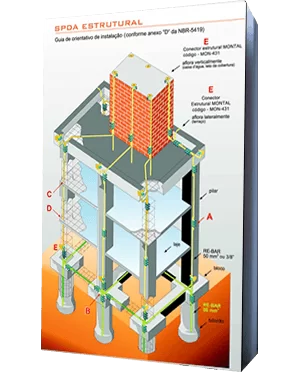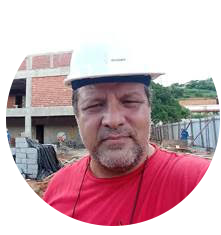ARTIGO NBR-16785-RESUMO ANEXO G
Procedimentos de segurança para a redução de risco fora da estrutura Este documento é uma
For more content and language variations check out the "catalogues" section at the top of the page
Complete line of products for PDA assembly, from grounding, descents, capture to equipotentialization/MPS.

Catalog covers specification of fittings, step-by-step instruction with performance tips, inspection and related products.

Practical orientation guide for the application of REBAR rebars, splices with clips and inserts according to NBR-5419.

Autocad library drawings guide covering SPDA assembly details.

Montal’s history comes along with the first SPDA (atmospheric discharge protection systems) in Brazil. Pioneer in Minas Gerais, it was the first company in the state specialized in the area to operate in the manufacture os parts and installation of protection systems against the direct incidence os atmospheric discharge, the lightning protection systems.



Discover the latest trends and innovative solutions on our blog! Don’t miss the opportunity to expand your knowledge and stay ahead.
Procedimentos de segurança para a redução de risco fora da estrutura Este documento é uma
ASSUNTO: PARA-RAIOS RADIOATIVOS TÓPICOS: Introdução / Resolução CNEN/04/09 / Identificando um Pára-Raios Radioativo / Procedimentos de
ASSUNTO: ATERRAMENTO DE CERCAS EM AREAS RURAIS TÓPICOS: Introdução / Solução I – INTRODUÇÃO: Uma nuvem
For quotes, just send a message with the list of desired products to the email comercial@montal.com.br along with your registration data (CNPJ, name, telephone and contact email).
If you prefer, call our commercial sector at (31) 3476-7675 or user the quote on the website. We do not make budgets without proper registration.
Choose one of our service channels according to the subject:
Commercial affairs: comercial@montal.com.br
Technical matters/doubts: nuno@montal.com.br
Financial and tax matters: Financeira@montal.com.br
Purchasing / supplier affairs: montal@montal.com.br
Telephone: (31) 3476-7675
WhatsApp: (31) 99238-0190 (our link: https://tinyurl.com/yysndwhu).
To make a budget through the website is very simple. Access the section of the desired product using the “Products” tab or write the name of the item in the search bar. Then select the desired model and quantity and click the “add to quote” button. The product will go to the shopping cart at the top of the page. On the cart page, with all the desired products already selected and with the correct quantities, click on the “continue to send the quotation “button. If you are not logged in on the website, you will be asked for some basic information, which after being filled in, simply click on the “send your quote request” button. Ready! The request will be sent by email to our commercial sector, and once received, one of our sellers will proceed with the service/response. Ah, you will receive a copy of the generated listing in your name.
The purpose of the Atmospheric Discharge Protection System – SPDA – is to protect a structure against the direct incidence of atmospheric discharges. Its operation consists of capturing the electric current from the lightning discharge and conducting it to the ground in an efficient manner, minimizing the destructive effects resulting from the direct incidence on buildings, reducing the risk of fire, damage to structures or accidents to people inside them. In Brazil it is standardized by ABNT NBR-5419/15. It is composed of several parts:
There are several ways to protect a structure. ABNT NBR-5419 provides for the three protection methods listed below and the types of usual systems.
Faraday Cage: Method that consists of a modular network of conductors involving all the sides of the structure to be protected (roof, facades), like a chess board, forming a kind of “cage”.
Electrogeometric Model: Method that determines a protection volume from the geometric development of a sphere around a captor (pole or mast higher than the structure to be protected).
Franklin: A method that determines a protection angle as a function of the height of the captor.
Structural: It is a type of system that uses a specific conductor of hot-dip galvanized steel, the RE-BAR, embedded in the structure along with reinforced concrete of pillars and foundations, with the function of dissipating the lightning discharge.
Natural: It is a type of system that considers metallic elements of the structure (roof tiles, profiles, pipes, etc.) as part of the SPDA. The structural system is considered natural.
Mixed: Combination of various methods/types of protection.
According to the regulatory standard of the Ministry of Labor and Employment (MTE), NR-10, structures must ensure safety to users in relation to electricity, and the PDA – protection against atmospheric discharges – an item provided for safety according to this federal regulation. Also by the code of consumer protection when buying a house or apartment, for example, this product must offer safety to the user. In some cities in Brazil there are municipal laws that require the PDA, as well as some entities that also require it, such as insurance companies, quality and safety certifiers, fire departments, among others. To determine the need or not of the PDA, the RISK MANAGEMENT must be done, which is a calculation memory foreseen in the ABNT NBR 5419-2/2015 standard that will determine the need and the adequate protection measures to minimize the risks caused by lightning.
The SPDA class is linked to the level of lightning protection of a system, and ranges from I to IV. It can be a more rigorous class, corresponding to class I, for example, to be adopted in an explosive material industry (oil refinery, fireworks factory, chemical plant) in which an accident caused by lightning would have enormous consequences, or a minimal protection class, less rigorous (class IV), that can be adopted in a residence. The determination of the protection class is done by RISK MANAGEMENT, which is a calculation memory provided in the ABNT NBR 5419-2/2015 standard. In this calculation several information is taken into account, such as dimensions, content and location of the structure, number of people, number of lightning strikes per km² per year of the place, if it has a fire prevention and combat system, among several other variables that will interfere in the rigor of the protection measures and consequently in the determination of the SPDA class.
It is a calculation memory provided in part 2 of the standard ABNT NBR 5419-2/2015 that has the purpose of providing a procedure to assess the risks in a structure due to atmospheric discharges. There are 4 types of risk: R1: risk of loss of human life; R2: risk of loss of public service; R3: risk of loss of cultural assets; R4: risk of loss of economic values. By adopting this calculation it will be possible to choose the appropriate protection measures to reduce the risks to a tolerable limit.